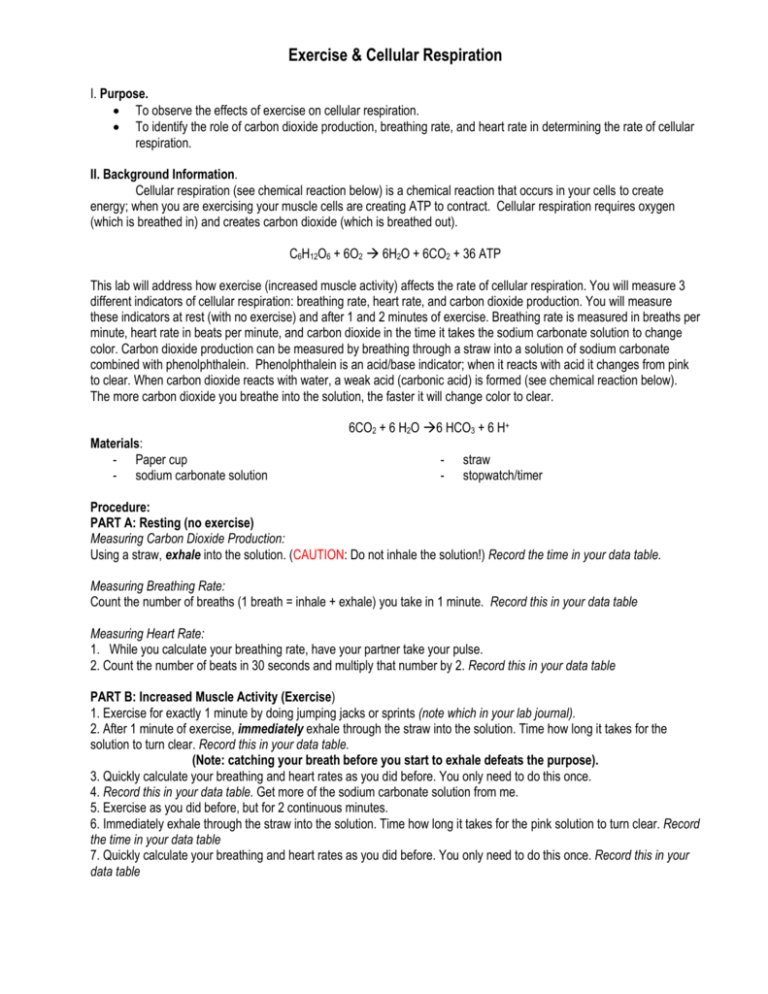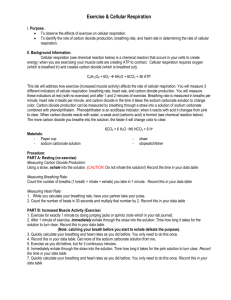Exercise & Cellular Respiration Lab: CO2, Breathing, Heart Rate
advertisement

Exercise & Cellular Respiration I. Purpose. To observe the effects of exercise on cellular respiration. To identify the role of carbon dioxide production, breathing rate, and heart rate in determining the rate of cellular respiration. II. Background Information. Cellular respiration (see chemical reaction below) is a chemical reaction that occurs in your cells to create energy; when you are exercising your muscle cells are creating ATP to contract. Cellular respiration requires oxygen (which is breathed in) and creates carbon dioxide (which is breathed out). C6H12O6 + 6O2 6H2O + 6CO2 + 36 ATP This lab will address how exercise (increased muscle activity) affects the rate of cellular respiration. You will measure 3 different indicators of cellular respiration: breathing rate, heart rate, and carbon dioxide production. You will measure these indicators at rest (with no exercise) and after 1 and 2 minutes of exercise. Breathing rate is measured in breaths per minute, heart rate in beats per minute, and carbon dioxide in the time it takes the sodium carbonate solution to change color. Carbon dioxide production can be measured by breathing through a straw into a solution of sodium carbonate combined with phenolphthalein. Phenolphthalein is an acid/base indicator; when it reacts with acid it changes from pink to clear. When carbon dioxide reacts with water, a weak acid (carbonic acid) is formed (see chemical reaction below). The more carbon dioxide you breathe into the solution, the faster it will change color to clear. Materials: - Paper cup - sodium carbonate solution 6CO2 + 6 H2O 6 HCO3 + 6 H+ - straw stopwatch/timer Procedure: PART A: Resting (no exercise) Measuring Carbon Dioxide Production: Using a straw, exhale into the solution. (CAUTION: Do not inhale the solution!) Record the time in your data table. Measuring Breathing Rate: Count the number of breaths (1 breath = inhale + exhale) you take in 1 minute. Record this in your data table Measuring Heart Rate: 1. While you calculate your breathing rate, have your partner take your pulse. 2. Count the number of beats in 30 seconds and multiply that number by 2. Record this in your data table PART B: Increased Muscle Activity (Exercise) 1. Exercise for exactly 1 minute by doing jumping jacks or sprints (note which in your lab journal). 2. After 1 minute of exercise, immediately exhale through the straw into the solution. Time how long it takes for the solution to turn clear. Record this in your data table. (Note: catching your breath before you start to exhale defeats the purpose). 3. Quickly calculate your breathing and heart rates as you did before. You only need to do this once. 4. Record this in your data table. Get more of the sodium carbonate solution from me. 5. Exercise as you did before, but for 2 continuous minutes. 6. Immediately exhale through the straw into the solution. Time how long it takes for the pink solution to turn clear. Record the time in your data table 7. Quickly calculate your breathing and heart rates as you did before. You only need to do this once. Record this in your data table 9. If there is time, repeat the entire procedure for your lab partner. Record data from 2 OR 3 other subjects in the class to get more data depending on if you partner was able to go or not. Results: Analysis & Conclusions: Answer the questions below using your BACKGROUND information in the lab, as well as your lab data. ANSWER THE QUESTIONS IN COMPLETE SENTENCES 1. How did exercise affect the time needed for the solution to change color? Explain why the color change occurred 2. What can you conclude about the effect of exercise on the amount of carbon dioxide that is present in your exhaled breath? Why is this so? 3. What can you conclude about the effect of exercise on breathing rate? Why is this so? 4. What can you conclude about the effect of exercise on heart rate? Why is this so? What do your muscles need during exercise that the blood brings? 5. State whether your hypothesis was correct or incorrect and why. In doing so, discuss what you think is going on in the muscles of the body as muscle activity is increased. Address the need to get oxygen to the muscles and get rid of carbon dioxide, as well as how the muscles cells get the energy needed to continue contracting. TEACHER NOTES: The sodium carbonate solution is a large volume of water (1000 mL) with a small amount of Na2CO3 (~1 gram) and a few drops of phenolphthalein solution to turn the solution pink. Sodium carbonate, while commonly available in science labs, can also be found as washing soda or soda ash. Exact measurements are not important but you will want to test your solution prior to the lab to ensure it will change color in the time needed. You can adjust the concentrations as needed. Phenolphthalein is a bright fuchsia color when added to a basic solution (such as the sodium carbonate); it turns colorless when its pH drops below 8.2. Mentioning its prior use as a laxative typically discourages students from tasting or inhaling their solution. The phenolphthalein molecule is colorless; however, the phenolphthalein ion is pink. When a base is added to the phenolphthalein, the molecule ⇌ ions' equilibrium shifts to the right, leading to more ionization as H+ ions are removed. This is predicted by Le Chatelier's principle. Before beginning the experiment, students should practice finding a pulse on their participant. It is important that measurements are taken immediately after exercising and not after they’ve ‘caught their breath’. Analysis & Conclusions: 1. How did exercise affect the time needed for the solution to change color? Explain why the color change occurred Exhaling carbon dioxide causes the basic solution to become more acidic (neutral). Increase in aerobic activity increases the rate of carbon dioxide production. This results in a quicker color change (to clear) as the pH dropped. 2. What can you conclude about the effect of exercise on the amount of carbon dioxide that is present in your exhaled breath? Why is this so? When you exercise, the muscles you use require more energy. When exercise can be sustained, this demand is met primarily by aerobic means. Aerobic energy production in muscles results in increased gas exchange at the lungs, because more oxygen is taken in and more carbon dioxide is released. Your blood transports these metabolic gases to and from your tissues. During exercise, your body needs more energy, which means your tissues consume more oxygen than they do at rest. Consuming more oxygen means you will also produce more carbon dioxide because your metabolic rate is elevated. The ratio of carbon dioxide produced per oxygen consumed also increases during exercise because a shift from fat to carbohydrate utilization takes place. At the most challenging work rates, you burn carbohydrates exclusively and produce 1.0 liter of carbon dioxide for every liter of oxygen you consume. 3. What can you conclude about the effect of exercise on breathing rate? Why is this so? During exercise, your lungs are responsible for delivering more oxygen to your cells as they use up all available reources. Faster consumption of oxygen means faster (and often deeper) breathing to keep up with this deficiency. 4. What can you conclude about the effect of exercise on heart rate? Why is this so? What do your muscles need during exercise that the blood brings? While you are exercising, as oxygen is entering the blood in the lungs and the cells are absorbing oxygen in the capillaries, blood is moving through the body to deliver the good and remove the bad. A faster heart rate means more blood is getting to the lungs and the tissues faster. 5. State whether your hypothesis was correct or incorrect and why. In doing so, discuss what you think is going on in the muscles of the body as muscle activity is increased. Student answers will vary.







